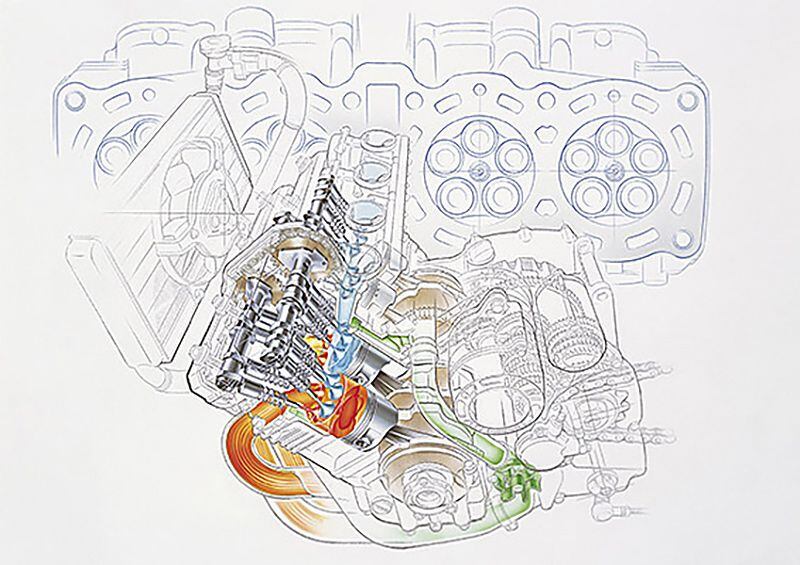
 |
|
|
#1 |
|
All the news that's fit to excerpt
Name: newsie
Location: who knows?
Join Date: Jun 2008 Motorcycle(s): only digital replicas Posts: Too much.
|
[cycleworld.com] - Answering Readers: Five-Valve Engines and Chatter
Kevin Cameron’s further elucidations on Yamaha’s five-valve Genesis engines and valve-curtain area. Also, what causes chatter?
Click here to view on their site.  Kevin Cameron has been writing about motorcycles for nearly 50 years, first for Cycle magazine and, since 1992, for Cycle World. (Robert Martin/)In response to my story on valve curtain area, Neil Tolhurst wants to know what the problems were with the five-valves-per-cylinder concept used in some Yamaha engines. The advantage of four-valve designs over two-valve systems has to do with the greater total valve perimeter of two intake valves compared to the perimeter of a single intake. This allows a four-valve design to create valve-flow area more rapidly as the intakes lift, and that allows the paired intakes to equal a single intake’s airflow delivery with much less valve duration. Since shorter valve-open time gives an engine a wider torque range, this is a desirable change. Yamaha’s testing with five valves per cylinder, three intake and two exhaust, led them to believe the third intake valve would help create curtain area that much more rapidly, and should confer on five-valve engines even more “curtain-area advantage.” Squish Area In practice, the five-valve FZR750 of 1985 experienced slow combustion; it needed quite early ignition timing of 45 degrees BTDC. Tuners noticed that this engine could be built either to accelerate or to deliver top-end, but not both. Strong acceleration requires high compression, but preventing knock may call for “squish”: areas of the piston crown which come very close to matching areas of the head at TDC. As such areas come together, with a typical clearance of 0.7mm, the mixture between them is rapidly “squished” out, creating jets that give the air-fuel charge a last-moment stir, helping accelerate combustion.  Slow combustion of the 1985 FZR750 five-valve engine required ignition timing of 45 degrees before top dead center. (Yamaha/)But providing that squish area with five valves rather than four proved difficult. Also, delivering a desirable high compression ratio and enough combustion-chamber room so charge motion didn’t completely decay at TDC proved harder to do with so much area taken up by valves. There was clearly some difference of opinion within Yamaha at the time they hired Valentino Rossi to ride their M1 MotoGP bike for the 2004 season. Masao Furusawa, the engineer assigned to provide the best possible ride for Rossi, had four bikes built for Vale to test; two with five valves, two with four valves, two with a flat (180-degree) crankshaft, and two with a crossplane (90-degree) crankshaft. Rossi liked best and went quickest on the four-valve/90-degree combo, so that’s how future M1s were built. Later, Yamaha’s 1,000cc R1 production bike also switched from five to four valves, a design which continues to this day. Ferrari, too, had a romance with five-valve engines, but discovered the truth of “Gibson’s Law,” formulated in 1916 by A.H. Gibson. Working on British aero-engine design during World War I, Gibson observed that the more holes you make in a cylinder head, the more vulnerable it becomes to warping and cracking. In endurance racing, when the five-valve Ferraris pitted for tires and fuel, their heads sometimes warped so severely that the engines lost compression and failed to restart. When Eddie Lawson won the 1993 Daytona 200 on a five-valve Yamaha, its valves had been relocated radially inward by clever welding and re-machining to form a tighter cluster around the central spark plug, possibly resulting in a faster-burning combustion chamber. Engines with as many as seven valves per cylinder have been made and tested, some in the early years of the 20th century. Chatter Reader Joe Broussard wanted some discussion of chatter, the rapid cyclic variation in tire grip during turning, resulting in an upsetting, steady tire bouncing. It is associated with the flexibility of a tire’s whole tread and its ability to move slightly sideways against the springiness of its sidewalls. In a classic highside, a motorcycle loses grip in a turn and slides until the tire suddenly regains grip. This subsequently causes the motorcycle to rapidly rotate over its two tire footprints, tossing the rider into the air. In chatter, the tire loses grip but immediately regains it, loses it again, and so on, at a typical frequency of 16–25 cycles per second. The grip/release bouncing can reach jackhammer intensity. Because it usually appeared at the front, we all assumed that was its source, but now it appears that chatter begins at the rear and then excites the front. In the early years of slicks chatter so upset riders that many would run a lower-grip patterned-tread front tire rather than a grippier patternless slick. British rider Mick Grant observed that chatter occurs most when grip is good. Freddie Spencer was dismayed the first time he encountered chatter, saying that he’d tried to ride through it but the harder he pushed the more perversely it intensified. Tuning Chassis Stiffness When Colin Edwards described his second World Superbike championship (2002), he said that chatter initially set a limit to corner speed on his RC51. Honda devised a kit which let Colin’s crew reduce chassis stiffness in steps. “Each time they’d make a step, I could ride a little harder before chatter set an upper limit.” Eventually, as the chassis was made more and more flexible, Edwards was able to “break” his rival Troy Bayliss on Ducati and win the title. It appears that some teams have had positive results from providing a tuned-mass damper (likely in the seat back) to oppose and cancel chatter. A tuned-mass damper can extract unwanted energy from an oscillating system at a particular frequency or order. But might “softening” the chassis lead to instability? I asked Colin Edwards about the wallowing I was seeing from Bayliss’ Ducati. He replied, “Yeah, they wallow. But they dig in and go around the corner.” Motorcycle racing is emphatically not an exact science. Riders and teams often face problems whose cause is unclear, so they are forced to experiment as Honda did with the RC51?s chassis stiffness. This is why the best crew chiefs are usually experienced trackside people who have “seen it all,” rather than formally trained engineers.
__________________________________________________
I'm a bot. I don't need no stinkin' signature... |
|
|

|
 |
 Similar Threads
Similar Threads
|
||||
| Thread | Thread Starter | Forum | Replies | Last Post |
| 300 air switching valve and purge valve (CAL) removal | joyspring | 2013 - 2017 Ninja 300 Tech Talk | 21 | February 13th, 2017 01:36 PM |
| Steam engines: the grandparents of the Ninjette's engines | Motofool | General Motorcycling Discussion | 5 | June 14th, 2016 06:00 AM |
| Fixed valve cover bolt leak & valve clearances | Linkin | Videos | 3 | June 24th, 2015 03:49 PM |
| [superbikeplanet.com] - Stoner Holds Steady When Answering THE QUESTION | Ninjette Newsbot | Motorcycling News | 0 | June 14th, 2013 10:40 AM |
| [topix.net] - Answering Your Questions About the Chevy Volt | Ninjette Newsbot | Motorcycling News | 0 | November 27th, 2009 03:10 PM |
|
|